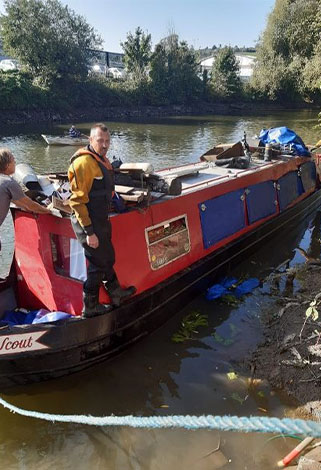With the world in a very precarious state at the moment due to the outbreak of the coronavirus, it is reassuring to find that apart from the medical experiments and research tests that are being conducted 24 hours a day throughout the world, that another form of vaccine / protection is being developed and is proving to be a considerable success.
Danish company UVD Robots from Odense have created a robot that can destroy microbe viruses by using an ultraviolet light. Vice president of the company Simon Ellison explained whilst demonstrating through a glass window of how the process works. “We have been growing our business at quite a huge pace, but the Covid 19 outbreak has accelerated the demand for the new robots”
Chief executive Per Juul Nielson added “ truckload`s of machines have been sent to
China especially to Wuhan where the outbreak first took place, sales in Asia and across Europe have increased dramatically since the virus spread across continents”
Mr Nielson stated that Italy on reflection had taken the main brunt of the disease along with Spain and the UK and at the moment and are in a desperate situation with the fatality rate rising on a daily basis.
Like every other country across the globe, everybody wants to try and help to curb the virus from getting worse than it already is.
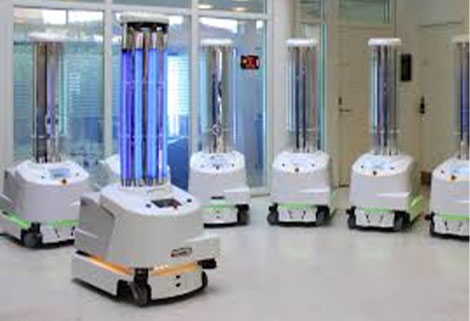
UVD robots on the frontline
Launched back in 2019 after an extensive 6 year trial experimental period between parent companies Blue Ocean Robotics and Odense University, the robots which cost £ 53,370 each, were designed to reduce the likelihood of hospital acquired infections which have surfaced over the past years and can be costly to treat due to the amount of care involved.
Because of the increase and fast spread of the virus throughout the world, production has significantly risen, and now takes less than one day to construct a machine.
Ultraviolet Light
So how does the robot work? Eight bulbs emit concentrated UC-C ultraviolet light that destroys bacteria, viruses and other harmful microbes by damaging its DNA or RNA, stopping it from multiplying further.
At the moment the process is damaging to humans, hence the demonstration behind a closed partition, but it is something that the companies are working on.
The process itself takes between 10-20 minutes per room, once finished there is a noticeable burning smell, something that can only be described like singed hair.
To be effective the UV needs to fall directly onto a surface, if light waves are blocked by dust or obstructions such as shadows or shaded areas, then the areas will not be treated, therefore manual cleaning is needed prior to the UV light being used.
The use of UV light is not new to the scientific field having been used for decades in air and water purification and also in various labs around the world, but by combining them with the autonomous robots they become a different thing altogether.
Professor Hans Jorn Kolmes of the University of Southern Denamrk quoted “if you apply a proper amount of ultraviolet light for an allocated period of time, you can be pretty sure that you will get rid of the organism, the type that have problematic strains that give rise to infections”.
This type of disinfection can also be applied to epidemic situations, like the current Coronavirus / Covid 19 example that we are dealing with right now.
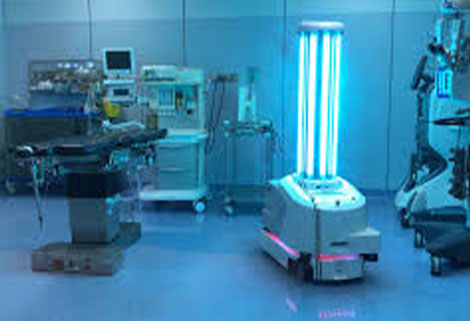
blue ocean robots at work
Although there is no significant proof that the robotic light can be effective against Covid 19, the experiments show that it is successful in killing other similar viruses such as Mers and Sars which have been killed by the use of the ultraviolet light.
Associate professor Dr Lena Ciric who is an expert on molecular biology at the University College London agrees that UV disinfection robots can help fight against the disease, she added “the robots are not silver bullets, but they do provide an extra line of defence alongside any medical or chemical breakthroughs”
Because we are experiencing more and more patients being admitted to our hospitals around the world, its more important than ever to be on top of the cleaning and decontamination routines, these robots definitely work in that area.
American company Xenex have also developed a robot called “Light Strike” which has to be manually put in place, but delivers high intensity UV light rays from a U shaped bulb
The firm has seen a huge rise in orders since the onset of the virus mainly from Italy, Japan, Thailand and South Korea.
Xenex said that numerous studies show that the Light Strike is effective at reducing hospital infections and combating relevant super bugs. One Texan hospital used it in their clean up operation after an Ebola case back in 2014.
Due to the Light Strikes success, more than 500 health clinics and hospitals throughout the US and beyond have installed one into their facilities.
In California and Nebraska it is already being put to good use by sanitising hospital rooms where coronavirus patients have been receiving treatment.
Technical Swerve
China has seen an incredible swerve towards new technology to help fight the disease, with the nation having the highest spend on drones and robotic systems.
Both Japan and China have been seen for years as the forerunners where technology is concerned, one thing is for sure, they will not stop until they find the solution.

Xenex light strike model
Robots have been used in a vast range of tasks for years, mainly for disinfection, deliveries, medical devices, waste control and temperature checking, so this is not new technology as such, but a merging of mechanical and medical minds.
Research Manager Leon Xian of IDC China said “We think this is a breakthrough for the greater use of robotics, both for hospitals and in public places”
Although the robots are efficient, humans have a natural sense of caution when it comes to change of their normal routines, ultimately time will tell and now is certainly the time to do so.
Because the virus originated in China, home grown scientists and technicians have been spurred on to create and develop a type of anti-body / vaccine whether it be mechanical or medical.
One such company YouiBot of Shenzhen were already developing autonomous robots, by adapting its technology to make a disinfection device which can be moved by using wheels and castors automatically, placing them in places without the use of any manual labour.
A YouiBot spokesman said “We have been trying to do something to help, for us technically it is not as difficult as people imagine, it is just finding the right formula, like building Lego”.
We have already supplied factories, offices, airports and hospitals in Wuhan.
The machines are running for 24 hours a day, checking body temperature during the day and are killing virus spores at night.
Due to the devastating affect the Coronavirus has had on manufacturers, plants, and engineering facilities, there has been a major problem getting parts and accessories to keep production and assembly lines moving, when a vital component is missing it slows down the production and hampers development.
Companies such as Bearingtech can help to solve these problems by supplying such parts and accessories to all major and minor establishments to help keep production moving in the right direction, which helps to keep the assembly lines and food production conveyor belts rolling.
Unfortunately most epidemics do not bring good news, when one does appear, companies including research labs, chemical companies, technical plants and inventive institutions step forward and try to solve the problems that they bring, the robotic side of technology has and will help in this situation.

YouiBot robots checking temperatures in public places daily
We are at present in the midst of the worst peacetime catastrophe since World War 2, when faced with problems or conflicts the human spirit and nature is to survive and to protect what we hold dear to us, whether the threat comes from an epidemic or military force, one thing is certain we must and will stand together and share our information for the good of all others, be sensible and think before we act no matter what this disease throws at us.
There is no doubt that this virus has got far worse than anyone expected, but be assured the people of the world will not rest on their laurels and wait, we will do whatever it takes to combat and defeat this threat to mankind.
Former president of the USA Ronald Reagan once said “If World War 3 is declared then no one will turn up due to the technical advancements that we have made”
This might not be a war in the conventional mould, but everyone on the planet will turn up, take part and defeat it!
 There are various roles available on the boat:
There are various roles available on the boat: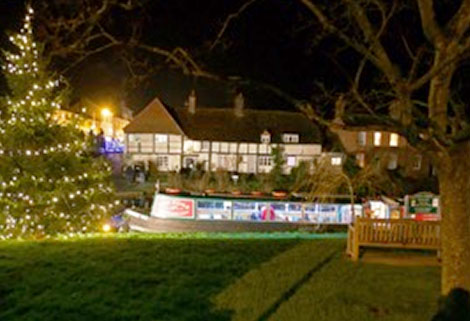 Children from the parish church have been taken each year on the Christmas cruise, with Santa on board. One year, I was taking the Minutes for the church council meeting and wrote in my notes, obviously without thinking, that the children were being offered the chance to book for Santa Cruz! “Sorry, we aren’t thinking of taking them that far,” was the leader’s comment!
Children from the parish church have been taken each year on the Christmas cruise, with Santa on board. One year, I was taking the Minutes for the church council meeting and wrote in my notes, obviously without thinking, that the children were being offered the chance to book for Santa Cruz! “Sorry, we aren’t thinking of taking them that far,” was the leader’s comment!
 Keeping that beautiful boat of yours in tip-top shape throughout the year can be a difficult task if you don’t know how to protect
Keeping that beautiful boat of yours in tip-top shape throughout the year can be a difficult task if you don’t know how to protect 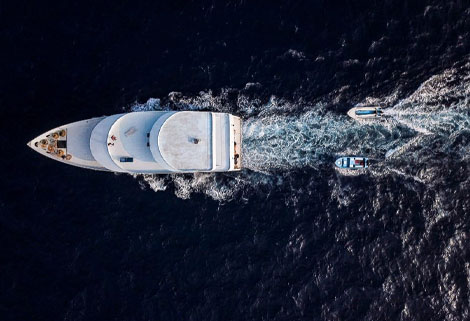 When it comes to
When it comes to  Of course, you can’t apply ceramic coating or any type of external protection before fixing and priming the paint job. Your mechanics should prime the exterior first by buffing and sanding out any irregularities, fixing any damage, and correcting the paintjob to create a seamless finish. Once that is done, they can start adding the ceramic coating to seal the surface and give it the level of protection it deserves to keep your boat looking pretty.
Of course, you can’t apply ceramic coating or any type of external protection before fixing and priming the paint job. Your mechanics should prime the exterior first by buffing and sanding out any irregularities, fixing any damage, and correcting the paintjob to create a seamless finish. Once that is done, they can start adding the ceramic coating to seal the surface and give it the level of protection it deserves to keep your boat looking pretty. Back in February I won the ‘Best Comedy’ award for my short stage play at The Worcestershire Theatre Festival.
Back in February I won the ‘Best Comedy’ award for my short stage play at The Worcestershire Theatre Festival. I was walking the dogs, Blue and Milly, down the towpath toward bridge number 38. It was coming to that weird sort of half-light between afternoon and dusk and we were happily trotting along - well the dogs were, I was shuffling about as usual - when a ghostly spectre appeared out of the mist (it wasn’t actually misty, but I’m trying to create an atmosphere, o.k?) A vision of Darth Vader appeared from under the arch and began to charge toward us at an alarming rate of knots. He was easily seven feet tall, dressed entirely in black, topped with a helmet with tinted visor. And - get this - he glided. Yes, that’s right, he glided - moving neither arms nor legs.
I was walking the dogs, Blue and Milly, down the towpath toward bridge number 38. It was coming to that weird sort of half-light between afternoon and dusk and we were happily trotting along - well the dogs were, I was shuffling about as usual - when a ghostly spectre appeared out of the mist (it wasn’t actually misty, but I’m trying to create an atmosphere, o.k?) A vision of Darth Vader appeared from under the arch and began to charge toward us at an alarming rate of knots. He was easily seven feet tall, dressed entirely in black, topped with a helmet with tinted visor. And - get this - he glided. Yes, that’s right, he glided - moving neither arms nor legs. As he drew level briefly, by now he was moving at just below subsonic speed, I saw that it was only some chap, in full motorcycle regalia, stood on - honestly, I kid you not - stood on a single motorised wheel about 2 feet (I’m not sure what that works out to in tonnes per hectare, or whatever it is these days) in diameter. Two footrests extended out from either side of the axle on which he balanced like a trick cyclist at the circus. I assume that he controlled the speed by leaning forward or back as they do on one of those Segway thingy’s you can hire out on your holibobs in Benidorm, but it was hard to tell as we were buffeted around in his wake amid a swirl of fallen autumn leaves, towpath dust and small dead mammals, slaughtered on his passage through the countryside.
As he drew level briefly, by now he was moving at just below subsonic speed, I saw that it was only some chap, in full motorcycle regalia, stood on - honestly, I kid you not - stood on a single motorised wheel about 2 feet (I’m not sure what that works out to in tonnes per hectare, or whatever it is these days) in diameter. Two footrests extended out from either side of the axle on which he balanced like a trick cyclist at the circus. I assume that he controlled the speed by leaning forward or back as they do on one of those Segway thingy’s you can hire out on your holibobs in Benidorm, but it was hard to tell as we were buffeted around in his wake amid a swirl of fallen autumn leaves, towpath dust and small dead mammals, slaughtered on his passage through the countryside.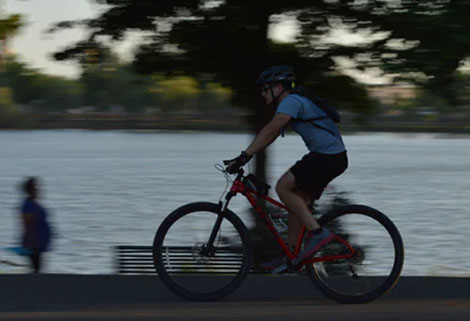
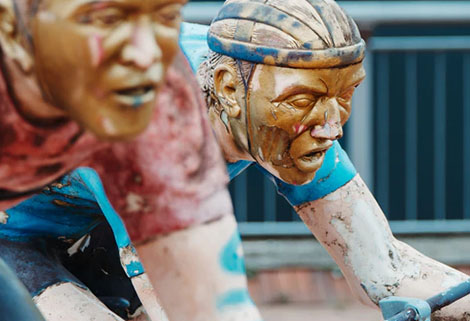 But the real culprit I’m afraid is Andy Street, Mayor of the West Midlands. He’s a champion of old style technology like trams, trains and of course bikes. I’m sure he’d like us all to become latter day Edwardians and am expecting him to launch an initiative soon to eschew our en-suite bathrooms in favour of building outdoor privy’s and wiping our bums on torn up squares from The Sun.
But the real culprit I’m afraid is Andy Street, Mayor of the West Midlands. He’s a champion of old style technology like trams, trains and of course bikes. I’m sure he’d like us all to become latter day Edwardians and am expecting him to launch an initiative soon to eschew our en-suite bathrooms in favour of building outdoor privy’s and wiping our bums on torn up squares from The Sun.
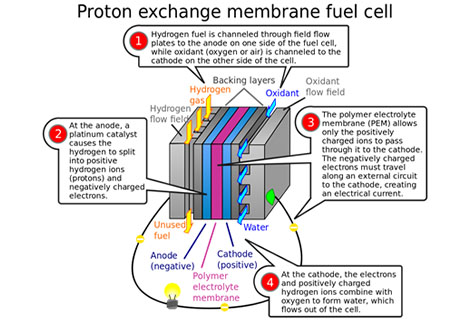 Now that industries such as transport and heating are struggling to maintain the levels needed using conventional batteries, hydrogen has come back into the frame. A typical example of this is the company JCB who have produced a new prototype mechanical digger which would need a battery weighing five tonnes and take hours to refuel.
Now that industries such as transport and heating are struggling to maintain the levels needed using conventional batteries, hydrogen has come back into the frame. A typical example of this is the company JCB who have produced a new prototype mechanical digger which would need a battery weighing five tonnes and take hours to refuel.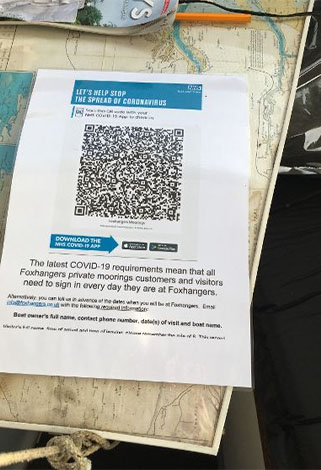 Having first done my tap and trace with a QR code laminated and stuck on Dawn Treader's door, I am writing this down below on a very stormy, blowy Halloween.
Having first done my tap and trace with a QR code laminated and stuck on Dawn Treader's door, I am writing this down below on a very stormy, blowy Halloween.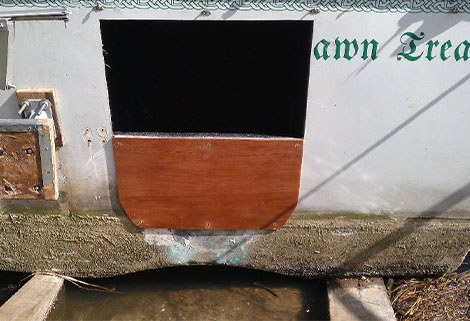 We are all exposed to a small amount of it when we run our engines, but generally the wind etc. takes most of it away. But the CO detector has already received a certain amount. However, at this very point in the canal I slow up for the bridge, which is on an acute angle so you can't see under it. The canal is in quite a deep cutting with high hedges both sides and steep banks with the wind directly behind me, so momentarily the exhaust gas catches up with me and briefly exceeds the level.
We are all exposed to a small amount of it when we run our engines, but generally the wind etc. takes most of it away. But the CO detector has already received a certain amount. However, at this very point in the canal I slow up for the bridge, which is on an acute angle so you can't see under it. The canal is in quite a deep cutting with high hedges both sides and steep banks with the wind directly behind me, so momentarily the exhaust gas catches up with me and briefly exceeds the level.
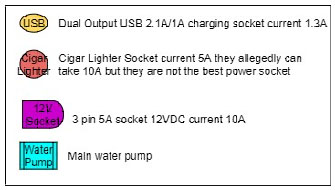 First the symbols chart and an explanation of each item the USB outlets, Cigar Lighter etc are I expect apparent what is not is the Wago. They are a modern version of the old chocolate block and a lot better. When wiring things like the USBs etc they can either be wired with one cable all the way back to their own individual fuse or the supply cable can be broken where each USB etc is to go and the supply cable broken and joined to run on to the next one.
First the symbols chart and an explanation of each item the USB outlets, Cigar Lighter etc are I expect apparent what is not is the Wago. They are a modern version of the old chocolate block and a lot better. When wiring things like the USBs etc they can either be wired with one cable all the way back to their own individual fuse or the supply cable can be broken where each USB etc is to go and the supply cable broken and joined to run on to the next one.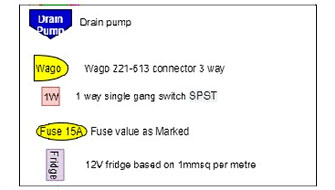 The Wago is the modern equivalent of the chocolate block connector but a 100 times better and unlike the Chocolate Block it does not damage the strands of the cables. It is also easier to fit, prepare the wire, lift the orange clip, slide the wire in, and push the orange clip back down job done. They cannot come open pushing the clip down locks them.
The Wago is the modern equivalent of the chocolate block connector but a 100 times better and unlike the Chocolate Block it does not damage the strands of the cables. It is also easier to fit, prepare the wire, lift the orange clip, slide the wire in, and push the orange clip back down job done. They cannot come open pushing the clip down locks them.


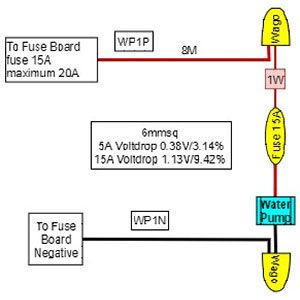



 For some reason which I am yet to fathom, I signed up to complete two half-marathons, three 10K races, climb Snowdon, the Yorkshire Three Peaks then, to top it all off, climb Mount Fuji. All within the year.
For some reason which I am yet to fathom, I signed up to complete two half-marathons, three 10K races, climb Snowdon, the Yorkshire Three Peaks then, to top it all off, climb Mount Fuji. All within the year. I don’t live too far from the canal. So why hadn’t I thought about it before? It’s quiet, peaceful, no traffic, no pollution, it’s interesting and there are no preening blokes. Actually, there are preening blokes, but that’s another story (see chapter 3). The towpath soon became my regular training ground but running back and forth along the same path soon became pretty boring.
I don’t live too far from the canal. So why hadn’t I thought about it before? It’s quiet, peaceful, no traffic, no pollution, it’s interesting and there are no preening blokes. Actually, there are preening blokes, but that’s another story (see chapter 3). The towpath soon became my regular training ground but running back and forth along the same path soon became pretty boring. Luckily, I discovered the Warwick Ring on my doorstep. A 115 mile circular route in the Midlands, using 5 different canals, crossing 4 counties, connecting 2 cities, 7 towns and many hamlets and villages. You may have guessed it, I like a challenge. So, to make life a little more interesting, I decided to travel this circular route only clockwise, without turning back, and using public transport to get to the start and for the return journey home. This meant training sessions became much longer, often starting before dawn and always taking up the whole day, with lots of public transport (something I’m not too familiar with or very good at).
Luckily, I discovered the Warwick Ring on my doorstep. A 115 mile circular route in the Midlands, using 5 different canals, crossing 4 counties, connecting 2 cities, 7 towns and many hamlets and villages. You may have guessed it, I like a challenge. So, to make life a little more interesting, I decided to travel this circular route only clockwise, without turning back, and using public transport to get to the start and for the return journey home. This meant training sessions became much longer, often starting before dawn and always taking up the whole day, with lots of public transport (something I’m not too familiar with or very good at). Well, this opened up a whole new world to me, travelling between idyllic rural tranquillity and industrial urban grunge. Seeing the wonders of our canal system up close and personal, much of it built around 250 years ago, with no satellites or software to work out the best route, or earth-moving equipment to dig the path. Concrete wasn’t developed until the mid 1800’s and the only means of transport across the land was by horse or foot.
Well, this opened up a whole new world to me, travelling between idyllic rural tranquillity and industrial urban grunge. Seeing the wonders of our canal system up close and personal, much of it built around 250 years ago, with no satellites or software to work out the best route, or earth-moving equipment to dig the path. Concrete wasn’t developed until the mid 1800’s and the only means of transport across the land was by horse or foot.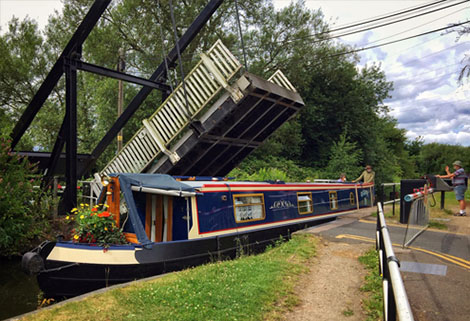 I was amazed at the sheer magnitude of this bold engineering project, built by Navvies using the simplest of tools, just pickaxe and shovel, a little gunpowder and loads of blood, sweat and tears. Travelling through my hometown, Birmingham, was like entering another world, one I didn’t recognise. It felt like I was crawling through the bowels of the city, literally seeing everything from a completely different perspective. I was awestruck.
I was amazed at the sheer magnitude of this bold engineering project, built by Navvies using the simplest of tools, just pickaxe and shovel, a little gunpowder and loads of blood, sweat and tears. Travelling through my hometown, Birmingham, was like entering another world, one I didn’t recognise. It felt like I was crawling through the bowels of the city, literally seeing everything from a completely different perspective. I was awestruck. After completing the challenges, I continue to walk the ring, completing the whole route at least once a year. The slower pace allows time for the occasional chat with interesting and quirky characters along the way and with a rich vein of history to dip into and discover. From Iron Age to Jet Age, the Gun Powder Plotters to the Peaky Blinders, with some unexpected finds.
After completing the challenges, I continue to walk the ring, completing the whole route at least once a year. The slower pace allows time for the occasional chat with interesting and quirky characters along the way and with a rich vein of history to dip into and discover. From Iron Age to Jet Age, the Gun Powder Plotters to the Peaky Blinders, with some unexpected finds. Having to use public transport certainly adds a new dimension to the already entertaining canalsy goings-on, transforming my once boring training sessions into unexpected adventures, sometimes a tiny bit weird, often hilarious, always eventful and inevitably informative. There is also the occasional, unfortunate mishap along the way, but nothing too serious. Yet. I posted a few of these adventures onto my Facebook page and got some great feedback. Then, a friend of mine said “… why don’t you write a book?” And that was the seed I needed to create ‘Canal is King”.
Having to use public transport certainly adds a new dimension to the already entertaining canalsy goings-on, transforming my once boring training sessions into unexpected adventures, sometimes a tiny bit weird, often hilarious, always eventful and inevitably informative. There is also the occasional, unfortunate mishap along the way, but nothing too serious. Yet. I posted a few of these adventures onto my Facebook page and got some great feedback. Then, a friend of mine said “… why don’t you write a book?” And that was the seed I needed to create ‘Canal is King”.
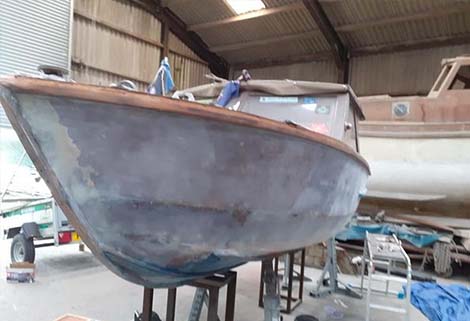
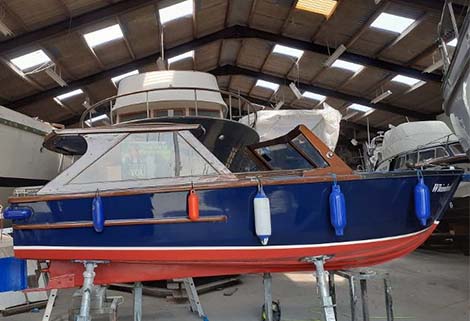
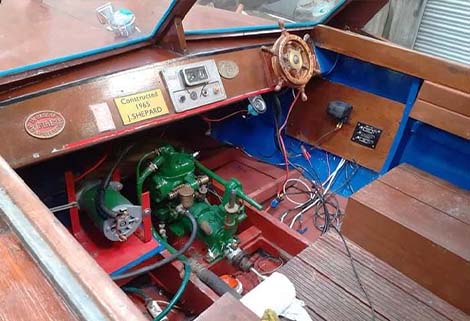
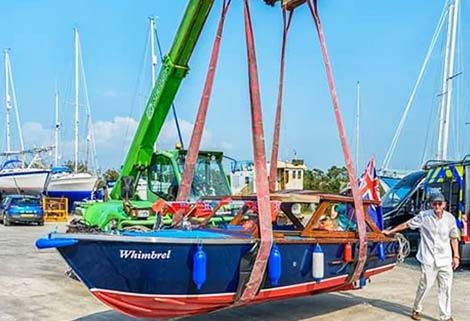

 Colin, now already well in to another restoration project, is a regular fund raiser for the RNLI. He is currently planning a mammoth fund raising event with the RNLI for next year.
Colin, now already well in to another restoration project, is a regular fund raiser for the RNLI. He is currently planning a mammoth fund raising event with the RNLI for next year.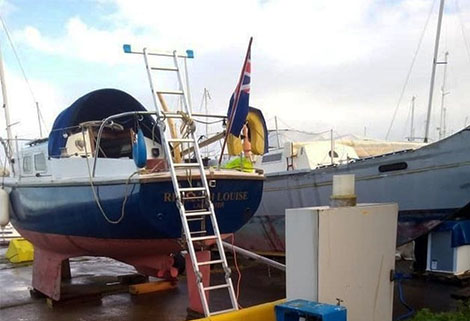 Colin is carrying out this second restoration in memory of their daughter who died when she was only three weeks old. Their daughter would now have been 20 years old.
Colin is carrying out this second restoration in memory of their daughter who died when she was only three weeks old. Their daughter would now have been 20 years old.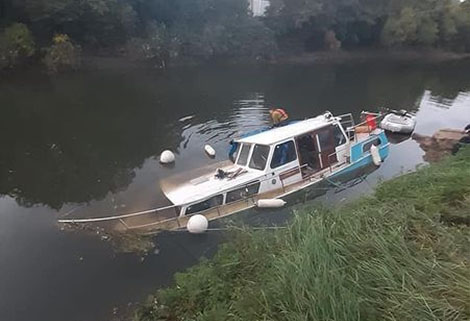 Following the failure of the Twerton sluice gates on the river Avon on Tuesday evening (15 Sept), River Canal Rescue has performed a logistical miracle, pulling teams and equipment together, at short notice, to recover 47 boats.
Following the failure of the Twerton sluice gates on the river Avon on Tuesday evening (15 Sept), River Canal Rescue has performed a logistical miracle, pulling teams and equipment together, at short notice, to recover 47 boats.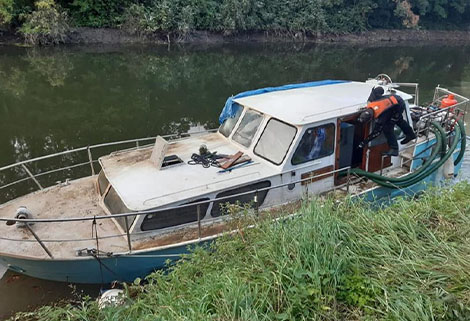 Despite supply issues created by the Covid climate, RCR met its deadline of Thursday to source and have all equipment on site and prepared for recoveries from 6am Friday.
Despite supply issues created by the Covid climate, RCR met its deadline of Thursday to source and have all equipment on site and prepared for recoveries from 6am Friday.